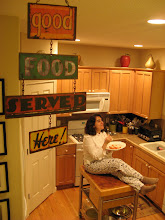It's also about the unctuous meat beneath…

But really it's all about that marvelous crisp and golden brown skin. It must be manipulated into puffing up like a chicharron. Like a pork doodle. Let me tell you about the process…
But first, I have a few tidbits to share. Fellow food writer Amy Rogers Nazarov quoted me in her article "Social Media" in the February issue of The ASJA Monthly—thanks for the interview, Amy! Michael Natkin over at Herbivoracious blogged these Homemade Caraway Rye Crackers based on my recipe for Semolina Crackers—how cool is that?! And I was featured on Mother Lovely—what an honor! I just have to say that knowing my work can give others inspiration in some small way is such an amazing feeling!

Chinese Roast Pork Belly
Printable Recipe
1 2 ½ pound piece skin-on pork belly
½ teaspoon baking soda
½ teaspoon Chinese five-spice
4 cloves garlic, thinly sliced
2 teaspoons rice vinegar
Kosher salt
Using a pair of fish tweezers, remove any bristles from the skin of the pork belly. Mix together the baking soda and 1 tablespoon of water in a dish that's just large enough to hold the pork belly. Add the pork belly skin side down, sprinkle the flesh side with the five-spice, and scatter over the garlic. Cover with plastic wrap and refrigerate overnight.
Discard the garlic. Transfer the pork to a paper towel-lined plate skin side down and drain for about a minute. Transfer the pork to a cutting board skin side up, brush the skin with the rice vinegar, and pat dry with paper towels. With a knife, score the skin with a diamond pattern, being careful not to pierce the flesh. Season the pork generously with salt. Transfer the pork to a rack on a roasting pan skin side up and refrigerate uncovered overnight.
Remove the pork from the refrigerator and set aside at room temperature for about an hour.
Preheat the oven to 450°F. Roast the pork for 20 minutes. Lower the temperature to 375°F and roast for another 35 to 45 minutes, or until cooked through. Turn the broiler on and cook, maneuvering the pork under the broiler as necessary so that it browns evenly, for 8 to 10 minutes or until the skin is golden brown and puffed all over. Remove the pork to a cutting board and allow to rest uncovered for 20 to 30 minutes before cutting. Cut the pork into bite-size pieces and serve immediately.
Serves 6 to 8. Start this recipe 2 days before you intend to serve it. Select a meaty piece of pork belly. The thick skin would ordinarily cook up hard and chewy. So how do we coax it into becoming an irresistible light crackling instead? It's a matter of breaking down the skin and drying it out (i.e. drawing out as much moisture as possible) before it goes into the oven and then using very high heat to cook it. This is accomplished with baking soda, vinegar, salt, refrigerating uncovered, and high heat roasting and broiling. (Many recipes call for scalding the pork skin by pouring boiling hot water over it as a first step, but I find this to be unnecessary if the pork is impeccably fresh and of the highest quality. I've also heard of people using baking powder, lye water, and even vodka for processing the skin.) Encouraging the fat to render, which is done by scoring (though you can pierce the skin all over, like hundreds of times, instead), is also key. Take care measuring and applying the baking soda as excess can react with the fat in the heat of the oven and cause a soapy off flavor. Incidentally, one purpose of the vinegar in this recipe is to neutralize the baking soda to prevent that from happening. The pork must sit level on the roasting rack so that fat can run off as it renders—pooling fat will inhibit formation of the crackling—and so that it broils evenly. If it is not level, prop up the low spots with some wadded up pieces of foil. Position the pan on the center rack of the oven for the duration of the cooking time—do not move it up for the broiling step. One last thing, when the pork comes out of the oven, don't tent it with foil as it rests to prevent condensation from forming and sogging out the crackling.















